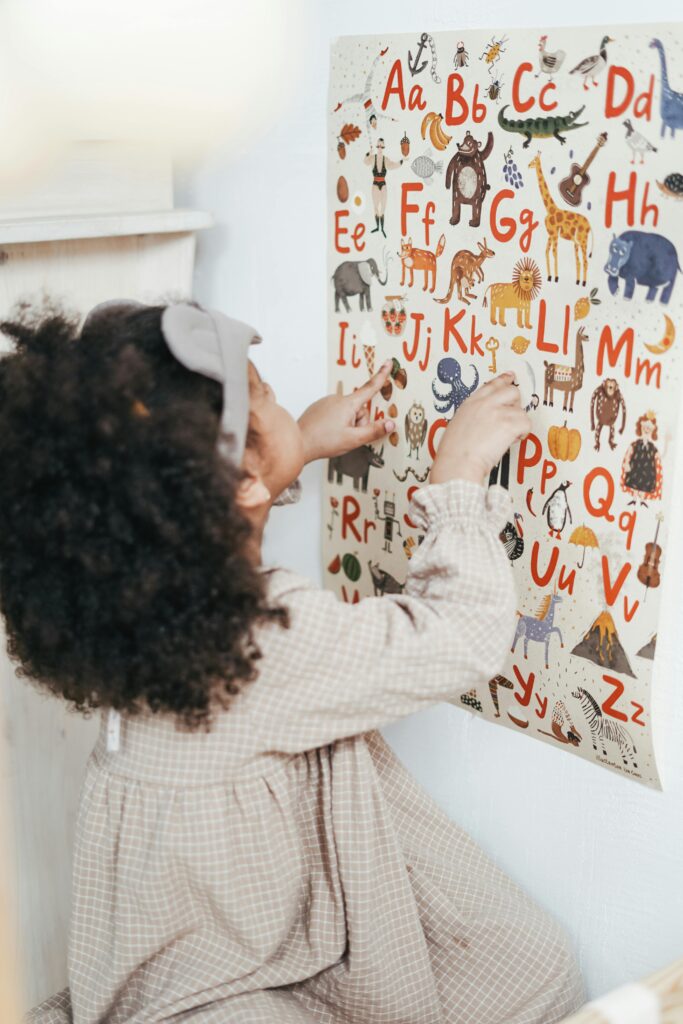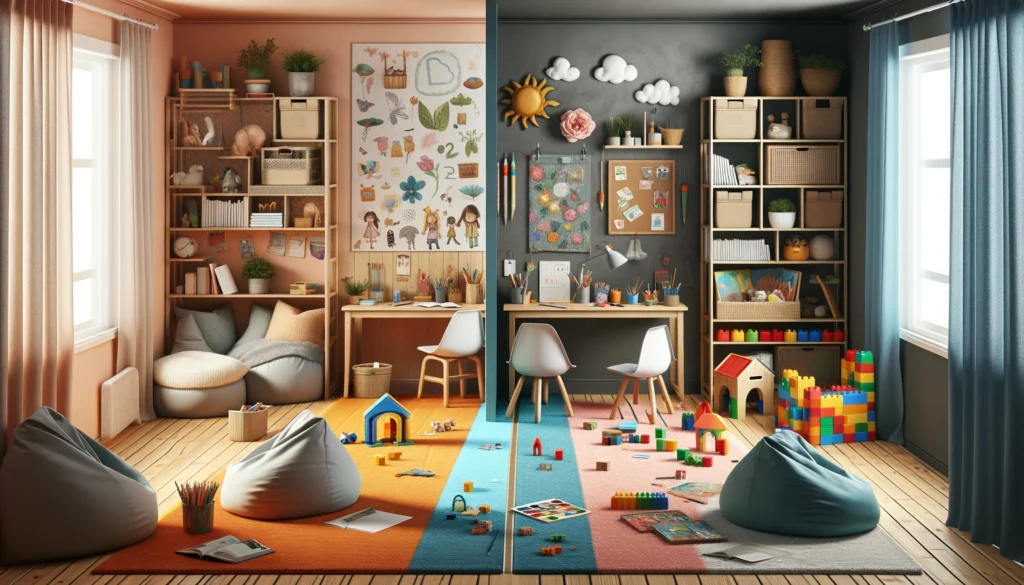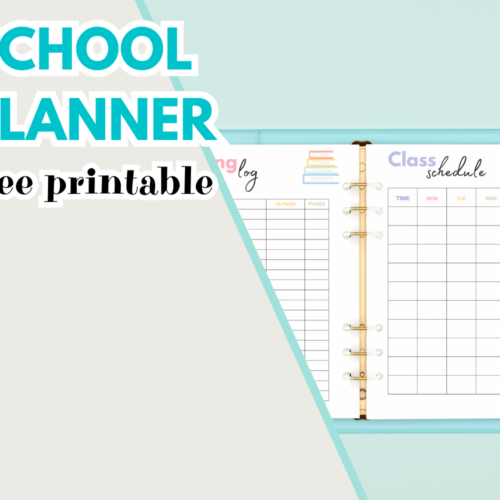Diving into homeschooling with my two little ones—a lively 3-year-old girl and her baby brother, just 3 months old—feels a bit like building a rocket ship out of LEGO: challenging but oh-so-rewarding. As an elementary teacher turned full-time mom, I’m all about creating a cozy yet effective learning nook in our not-so-big living space.
In this post, I’ll share the ins and outs of squeezing big dreams into a small homeschool room. We’re talking about everything from clever storage hacks to personal touches that make the space feel like us. Imagine a place where vertical space becomes your best friend, and multifunctional furniture is king. Plus, I’ve got some fun anecdotes and DIY projects up my sleeve that even my toddler gets excited about.
So, grab a cup of coffee and join me on this quirky adventure of turning a tiny corner of our home into a bustling hub of curiosity and learning. Let’s make this small space mighty together!
You may also like: THE ZEN OF HOMESCHOOL ORGANIZATION: TIPS FOR STRESS-FREE LEARNING AT HOME
Table of Contents
Maximizing Small Spaces
Maximizing small spaces for a homeschool room is like a puzzle where every piece must fit perfectly. As a mom juggling the joys and challenges of raising a curious 3-year-old and a sweet 3-month-old, I’ve learned that organization is key to maintaining sanity and sparking joy in learning.
Utilizing Vertical Space
Utilize the walls for storage and educational displays. Install shelves to keep books, supplies, and learning materials organized. Use magnetic boards or corkboards to hang posters, maps, and charts, which can be easily changed or updated to keep the learning environment dynamic.

Choose furniture that serves multiple purposes. For example, a table that can be used for writing, crafting, and experiments. Consider a foldable desk or a wall-mounted drop-leaf table to save space when not in use. Seating can include stackable stools or a bench with built-in storage.
Creating a Stimulating Learning Environment
Transforming a small space into a stimulating learning environment goes beyond mere decoration; it involves creating a space that fuels curiosity, inspires imagination, and turns learning into an engaging journey. As an elementary teacher and a dedicated mom, I’ve designed our homeschool room to cater to both the intellectual and emotional needs of children.
Colorful Educational Decor
Our room is a vibrant educational oasis. Walls are covered with posters that unravel the mysteries of the human body, the universe, and ecosystems, making every look a chance to learn something new. A world map invites dreams of adventure, and achievement charts celebrate progress, sparking joy and pride in my children.

Age-Appropriate Toys and Materials
The room is filled with carefully chosen toys and materials that blend learning with fun, catering to 1st to 4th graders. Building blocks introduce physics in an engaging way, while puzzles enhance problem-solving skills. These tools are not just toys but fundamental to fostering lifelong curiosity.
Personal Touches for a Welcoming Atmosphere
Allow your child to personalize their learning area with artwork, projects, or items that inspire them. This personal touch can make the small room feel more inviting and motivating.
Personal Touches
My 3-year-old’s involvement, from selecting the reading chair’s spot to the posters’ colors, emphasizes that this space belongs to her as much as it does to me. For our youngest, a cozy nook is envisioned, equipped with soft toys and picture books, ensuring he’s an integral part of our learning adventures.

DIY Decor
Together, my daughter and I ventured into DIY projects that bring our personalities into the room. We’ve crafted hand-painted alphabet letters, each reflecting her creative spirit, and a number line that stretches across the room, marking an afternoon of joy and teamwork. These pieces not only brighten our space but also instill a deep sense of pride and belonging.

Flexible Learning Areas
Instead of traditional chairs, consider flexible seating options like bean bags, floor cushions, or even a small sofa. These can make the space feel more comfortable and adaptable to various activities, from reading and studying to group discussions.
The homeschool room should combine a Quiet Zone for focused study with a Creative Playground for imaginative activities. The Quiet Zone is a peaceful corner for reading and problem-solving, while the Creative Playground is vibrant and dynamic, encouraging creativity. Flexible dividers allow the room to adapt, catering to both quiet reflection and lively exploration in a cohesive space.

Incorporating Nature and Science
In our homeschool setup, we integrate nature and science to foster discovery and hands-on learning. Our “Little Green Corner” features an indoor garden and terrarium, serving as live educational tools where lessons on plant life, care, and photosynthesis come alive. These natural elements teach responsibility and the wonders of growth directly through interaction.
Our living areas transform into science labs, utilizing everyday items for experiments that demystify concepts like chemical reactions and sound waves. Activities like a baking soda volcano or a water xylophone illustrate that learning extends beyond books, embedding science in the fabric of daily life.
This approach transforms our homeschool environment into a vibrant hub of exploration and learning, underlining the idea that education thrives on curiosity and the practical application of knowledge.
Technology Integration
With limited space, it’s essential to incorporate technology in a way that enhances learning without cluttering the area. A single, compact computer station, possibly a laptop or a tablet, can serve multiple educational purposes. Use digital resources and apps to complement physical learning materials.
To manage technology effectively, we’ve established a tech station for device storage and charging, promoting organization and limiting distractions. Setting specific times for technology use ensures a balanced approach to digital and hands-on learning, maintaining focus and enhancing educational experiences.
Adapting as They Grow
Opting for adjustable furniture and modular storage enables our space to evolve alongside my children, ensuring it remains conducive to their learning journey.
Adjustable desks and chairs accommodate their physical growth, while modular shelving meets the expanding requirements for book and resource storage. This adaptability ensures our homeschool room continues to foster a dynamic and supportive learning environment.
Anticipating future changes, our space is envisioned to transform with my children’s interests, from reading nooks to science labs or craft corners to coding stations. This forward-thinking approach ensures our homeschool environment remains relevant and engaging, reflecting the evolving journey of learning and discovery.
Conclusion
A small room doesn’t have to limit the quality of a homeschool experience. With careful planning and creative solutions, you can design a homeschool area that is both efficient and exciting for your child. Remember, the goal is to create a space that supports your child’s learning journey, fosters creativity, and adapts to their evolving educational needs.




[…] in small areas, offering flexibility for different activities without taking up too much room. Some real hacks for small spaces, […]